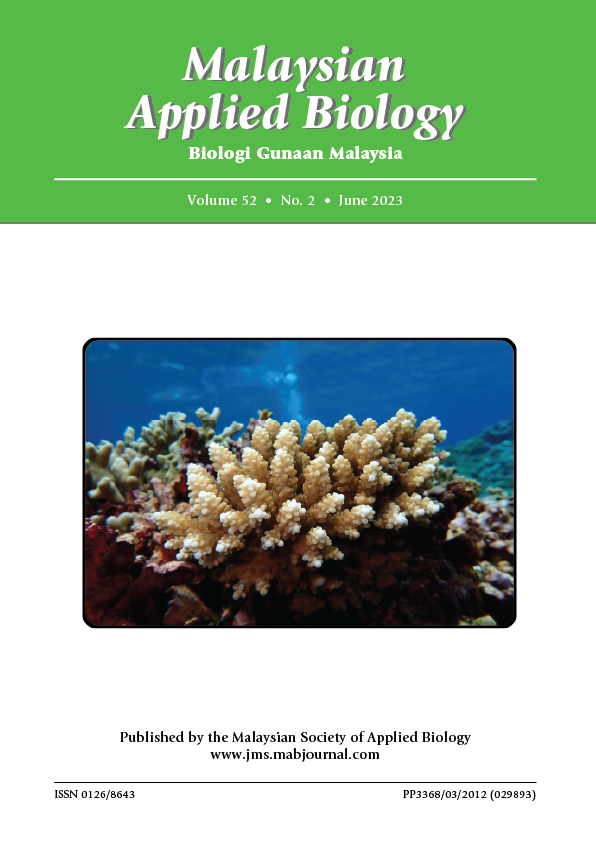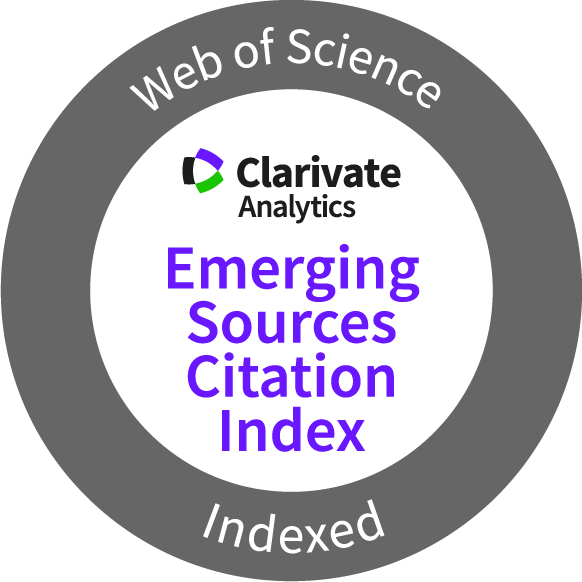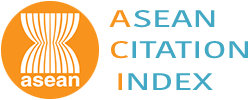Water Quality Analysis and The Occurrence of Antibiotic-Resistant Bacteria (ARB) From Satow Waterfall in Bau, Malaysian Borneo
Keywords:
Antibiotic Resistance, Water Quality, 16S rRNA sequencing, Kirby- Bauer Disk Diffusion Assay, Recreational waterAbstract
Water quality monitoring of a particular river is crucially important to determine if the river water meets the requirement for its designated uses. Therefore, an assessment of the physiochemical water quality at Satow Waterfall, Sarawak, and the prevalence of antibiotic-resistant bacteria (ARB) was conducted to corroborate the safety of the water from the waterfall. A total of 42 water samples were collected at the subsurface water of the upstream, midstream, and downstream on two sampling trips in June 2021 (dry season) and December 2021 (wet season), with six months intervals. The water quality index (WQI) of the sampling stations ranged from 92.60 to 95, classifying the water under Class I. However, the water is microbiologically polluted, with the highest coliform count of 2.59 × 105 CFU/mL recorded at the middle stream during the wet season, which has surpassed the regulatory standard set by the Malaysian Department of Environment (DOE). A total of 54 bacterial isolates were chosen as representatives and identified by 16S rRNA sequencing, which confirmed the existence of 21 bacterial genera. All identified isolates were tested against 15 antibiotics of various classes employing the Clinical and Laboratory Standards Institute (CLSI) protocols. The antibiotic susceptibility test (AST) demonstrated substantial resistance to sulfamethoxazole (48%) and erythromycin (48%), as well as high susceptibility to chloramphenicol (84%), levofloxacin (60%) and ofloxacin (60%). The Multiple Antibiotic Resistance Index (MARI) evaluations demonstrated the MARI varied from 0-0.60, with 33% of the isolates having a MARI greater than 0.2. In this study, the occurrence of ARB in a water environment where there is an undisclosed source of antibiotic utilization is still inevitable, highlighting the necessity to constantly monitor the water quality and the pervasiveness of ARB in recreational water.
Downloads
Metrics
References
Abe, K., Nomura, N. & Suzuki, S. 2020. Biofilms: hot spots of horizontal gene transfer (HGT) in aquatic environments, with a focus on a new HGT mechanism. FEMS Microbiology Ecology, 96(5): 1-12. DOI: https://doi.org/10.1093/femsec/fiaa031
Addgene. 2022. Protocol - How to Create a Bacterial Glycerol Stock. URL from https://www.addgene.org/protocols/create-glycerol-stock/ (accessed 7.10.22)
Ahmadpoor, N., Ahmadrajabi, R., Esfahani, S., Hojabri, Z., Moshafi, M.H. & Saffari, F. 2021. High-level resistance to erythromycin and tetracycline and dissemination of resistance determinants among clinical Enterococci in Iran. Medical Principles and Practice, 30(3): 272–276. DOI: https://doi.org/10.1159/000516216
Aiello, A.E., Marshall, B., Levy, S.B., Della-Latta, P., Lin, S.X. & Larson, E. 2005. Antibacterial cleaning products and drug resistance. Emerging Infectious Diseases, 11(10): 1565–1570. DOI: https://doi.org/10.3201/eid1110.041276
APHA. 2017. Standard Methods for the Examination of Water & Wastewater, Centennial Edition (21st Ed.). America Public Health Association.
Arnold, B.F., Wade, T.J., Benjamin-Chung, J., Schiff, K.C., Griffith, J.F., Dufour, A.P., Weisberg, S.B. & Colford, J.M. 2016. Acute gastroenteritis and recreational water: highest burden among young US children. American Journal of Public Health, 106(9): 1690–1697. DOI: https://doi.org/10.2105/AJPH.2016.303279
Barber, M. 1961. Hospital infection yesterday and today. Journal of Clinical Pathology, 14(1): 2–10. DOI: https://doi.org/10.1136/jcp.14.1.2
Ben, Y., Fu, C., Hu, M., Liu, L., Wong, M.H. & Zheng, C. 2019. Human health risk assessment of antibiotic resistance associated with antibiotic residues in the environment: A review. Environmental Research, 169: 483–493. DOI: https://doi.org/10.1016/j.envres.2018.11.040
Bordalo, A.A., Teixeira, R. & Wiebe, W.J. 2006. A water quality index applied to an international shared river basin: The case of the Douro River. Environmental Management, 38(6): 910–920. DOI: https://doi.org/10.1007/s00267-004-0037-6
Centers for Disease Control and Prevention. 2022. Swimming-related Illnesses | Healthy Swimming Healthy Water CDC. CDC. URL https://www.cdc.gov/healthywater/swimming/swimmers/rwi.html. (accessed 4.3.22)
Chouhan, S. 2014. Enumeration and identification of standard plate count bacteria in raw water supplies. Journal of Environmental Science, Toxicology and Food Technology, 9(2): 67–73.
Dolejska, M. & Papagiannitsis, C.C. 2018. Plasmid-mediated resistance is going wild. Plasmid, 99: 99–111. DOI: https://doi.org/10.1016/j.plasmid.2018.09.010
Fewtrell, L. & Kay, D. 2015. Recreational water and infection: A review of recent findings. Current Environmental Health Reports, 2(1): 85–94. DOI: https://doi.org/10.1007/s40572-014-0036-6
Fontana, C., Patrone, V., Lopez, C.M., Morelli, L. & Rebecchi, A. 2021. Incidence of tetracycline and erythromycin resistance in meat-associated bacteria: impact of different livestock management strategies. Microorganisms, 9(10): 2111. DOI: https://doi.org/10.3390/microorganisms9102111
Freundlich, J., Wang, F., Vilchèze, C., Gulten, G., Langley, R., Schiehser, G., Jacobus, D., Jacobs, W. & Sacchettini, J. 2009. Triclosan derivatives: Towards potent inhibitors of drug-sensitive and drug-resistant Mycobacterium tuberculosis. ChemMedChem, 4(2): 241–248. DOI: https://doi.org/10.1002/cmdc.200800261
Garba, B., Bahaman, A.R., Bejo, S.K., Zakaria, Z., Mutalib, A.R. & Bande, F. 2018. Major epidemiological factors associated with leptospirosis in Malaysia. Acta Tropica, 178: 242–247.
Garba, B., Bahaman, A.R., Bejo, S. K., Zakaria, Z., Mutalib, A.R. & Bande, F. 2018. Major epidemiological factors associated with leptospirosis in Malaysia. Acta Tropica, 178: 242–247. DOI: https://doi.org/10.1016/j.actatropica.2017.12.010
Ghazali, M.A.N. 2019. Leptospirosis & Typhoid Outbreak in Johor, Malaysia: Johor Malaysia. LAP LAMBERT Academic Publishing.
Hiltunen, T., Virta, M. & Laine, A.L. 2017. Antibiotic resistance in the wild: an eco-evolutionary perspective. Philosophical Transactions of the Royal Society B: Biological Sciences, 372(1712): 20160039. DOI: https://doi.org/10.1098/rstb.2016.0039
Hu, Y., Yang, X., Li, J., Lv, N., Liu, F., Wu, J., Lin, I.Y.C., Wu, N., Weimer, B.C., Gao, G.F., Liu, Y. & Zhu, B. 2016. The bacterial mobile resistome transfer network connecting the animal and human microbiomes. Applied and Environmental Microbiology, 82(22): 6672–6681. DOI: https://doi.org/10.1128/AEM.01802-16
Igere, B.E., Onohuean, H. & Nwodo, U.U. 2022. Water bodies are potential hub for spatio-allotment of cell-free nucleic acid and pandemic: a pentadecadal (1969–2021) critical review on particulate cell-free DNA reservoirs in water nexus. Bulletin of the National Research Centre, 46(1): 1-15. DOI: https://doi.org/10.1186/s42269-022-00750-y
Kathleen, M.M., Samuel, L., Felecia, C., Reagan, E.L., Kasing, A., Lesley, M. & Toh, S.C. 2016. Antibiotic resistance of diverse bacteria from aquaculture in Borneo. International Journal of Microbiology, 2016: 1–9. DOI: https://doi.org/10.1155/2016/2164761
Kraemer, S.A., Ramachandran, A. & Perron, G.G. 2019. Antibiotic pollution in the environment: From microbial ecology to public policy. Microorganisms, 7(6): 180. DOI: https://doi.org/10.3390/microorganisms7060180
Krumperman, P.H. 1983. Multiple antibiotic resistance indexing of Escherichia coli to identify high-risk sources of fecal contamination of foods. Applied and Environmental Microbiology, 46(1): 165–170. DOI: https://doi.org/10.1128/aem.46.1.165-170.1983
Kumar, A. 2011. CFU: Colony forming unit & calculation. Bio-Resource. URL http://technologyinscience.blogspot.com/2011/11/cfu-colony-forming-unit-calculation.html#.YygRkXZBy01 (accessed 5.10.22)
Lee Goi, C. 2020. The river water quality before and during the Movement Control Order (MCO) in Malaysia. Case Studies in Chemical and Environmental Engineering, 2: 100027. DOI: https://doi.org/10.1016/j.cscee.2020.100027
Leong, S., Ismail, J., Denil, N., Sarbini, S., Wasli, W. & Debbie, A. 2018. Microbiological and physicochemical water quality assessments of river water in an industrial region of the Northwest Coast of Borneo. Water, 10(11): 1648. DOI: https://doi.org/10.3390/w10111648
Lihan, S., Jamil, N.A., Jamian, M.A.H., Chiew, T.S., Ajibola, O.O., Justin, S., Benet, F. & Kion, L.N. 2020. Distribution and prevalence of antibiotic resistant bacteria in fish farms in East Malaysia. Malaysian Journal of Microbiology, 16(4): 263-274. DOI: https://doi.org/10.21161/mjm.190522
Lim, M.H. & Apun, K. 2013. Antimicrobial susceptibilities of Vibrio parahaemolyticus isolates from tiger shrimps (Penaeus monodon) aquaculture in Kuching, Sarawak. Research Journal of Microbiology, 8(1): 55–62. DOI: https://doi.org/10.3923/jm.2013.55.62
Ling, T.Y., Soo, C. L., Phan, T.P., Lee, N., Sim, S.F. & Grinang, J. 2017. Assessment of the water quality of Batang Rajang at Pelagus Area, Sarawak, Malaysia. Sains Malaysiana, 46(3): 401–411. DOI: https://doi.org/10.17576/jsm-2017-4603-07
Mohammad Hamdi, K., Lihan, S., Hamdan, N. & Tay, M.G. 2022. Water quality assessment and the prevalence of antibiotic- resistant bacteria from a recreational river in Kuching, Sarawak, malaysia. Journal of Sustainability Science and Management, 17(5): 37–59. DOI: https://doi.org/10.46754/jssm.2022.05.004
Mohd Ali, M.R., Mohamad Safiee, A.W., Thangarajah, P., Fauzi, M.H., Muhd Besari, A., Ismail, N. & Yean Yean, C. 2017. Molecular detection of leptospirosis and melioidosis co-infection: A case report. Journal of Infection and Public Health, 10(6): 894–896. DOI: https://doi.org/10.1016/j.jiph.2017.02.009
Morales-Durán, N., de la Torre-González, A., García-Sánchez, V. & Chávez, C. 2018. Estudio de la calidad bacteriológica y parámetros fisicoquímicos del agua del Distrito de Riego 023. Tecnología Y Ciencias Del Agua, 09(1): 53–67. DOI: https://doi.org/10.24850/j-tyca-2018-01-04
Naidoo, S. & Olaniran, A. 2013. Treated wastewater effluent as a source of microbial pollution of surface water resources. International Journal of Environmental Research and Public Health, 11(1): 249–270. DOI: https://doi.org/10.3390/ijerph110100249
Orhan, M. 2020. Triclosan applications for biocidal functionalization of polyester and cotton surfaces. Journal of Engineered Fibers and Fabrics, 15: 1-11. DOI: https://doi.org/10.1177/1558925020940104
Pepper, I.L. & Gerba, C.P. 2015. Cultural methods. Environmental Microbiology, 3: 195–212. DOI: https://doi.org/10.1016/B978-0-12-394626-3.00010-7
Pepper, I.L., Brooks, J.P. & Gerba, C. P. 2018. Antibiotic resistant bacteria in municipal wastes: is there reason for concern? Environmental Science & Technology, 52(7): 3949–3959. DOI: https://doi.org/10.1021/acs.est.7b04360
Polianciuc, S.I., Gurzău, A.E., Kiss, B., Ștefan, M.G. & Loghin, F. 2020. Antibiotics in the environment causes and consequences. Medicine and Pharmacy Reports, 93(3): 231-240. DOI: https://doi.org/10.15386/mpr-1742
Sapian, M., Khair, M.T., How, S.H., Rajalingam, R., Sahhir, K., Norazah, A., Khebir, V. & Jamalludin, A.R. 2012. Outbreak of melioidosis and leptospirosis co-infection following a rescue operation. The Medical Journal of Malaysia, 67(3): 293–297.
Staradumskyte, D. & Paulaukas, A. 2012. Indicators of microbial drinking and recreational water quality. Biologija, 58(1): 7-13. DOI: https://doi.org/10.6001/biologija.v58i1.2317
Sato, T., Ito, R., Kawamura, M. & Fujimura, S. 2022. The risk of emerging resistance to trimethoprim/sulfamethoxazole in Staphylococcus aureus. Infection and Drug Resistance, 15: 4779–4784. DOI: https://doi.org/10.2147/IDR.S375588
Taylor, E., Ferreira, G., Freitas, G., Ferreira, R., de Assis Santos, D. & de Resende-Stoianoff, M. 2017. Screening of antifungal susceptibility in cave-dwelling aspergilli and report of an amphotericin B-resistant Aspergillus flavus. International Journal of Speleology, 46(3): 369–378. DOI: https://doi.org/10.5038/1827-806X.46.3.2105
Teo, C.Y., Jong, J.S.J. & Chan, Y.Q. 2022. Carbon-based materials as effective adsorbents for the removal of pharmaceutical compounds from aqueous solution. Adsorption Science & Technology, 2022: 3079663. DOI: https://doi.org/10.1155/2022/3079663
USEPA. 2022. Fecal bacteria | monitoring & assessment. EPA. URL https://archive.epa.gov/water/archive/web/html/vms511.html (accessed 6.10.22)
Wade, T.J., Arnold, B.F., Schiff, K., Colford, J.M., Weisberg, S.B., Griffith, J.F. & Dufour, A.P. 2022. Health risks to children from exposure to fecally-contaminated recreational water. PLoS ONE, 17(4): e0266749. DOI: https://doi.org/10.1371/journal.pone.0266749
Wu, J., Huang, Y., Rao, D., Zhang, Y. & Yang, K. 2018. Evidence for environmental dissemination of antibiotic resistance mediated by wild birds. Frontiers in Microbiology, 9: 745. DOI: https://doi.org/10.3389/fmicb.2018.00745
Zhu, H., Sandiford, S.K. & van Wezel, G.P. 2014. Triggers and cues that activate antibiotic production by actinomycetes. Journal of Industrial Microbiology and Biotechnology, 41(2): 371–386. DOI: https://doi.org/10.1007/s10295-013-1309-z
Published
How to Cite
Issue
Section
Any reproduction of figures, tables and illustrations must obtain written permission from the Chief Editor (wicki@ukm.edu.my). No part of the journal may be reproduced without the editor’s permission
Funding data
-
Universiti Malaysia Sarawak
Grant numbers UNI/I01/VC-HIRG/85485/P03-02/2022





















